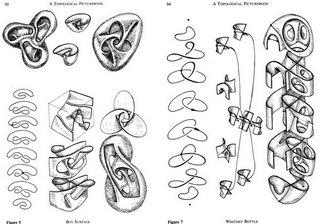20070921

G. Francis, A Topological Picture Book
Assignment_03
"A map which uses a set of rules to transform elements of a sequence into a new sequence using a set of rules which "translate" from the original sequence to its transformation. For example, the substitution system (1-> 0, 0-> 11) would take 10-> 011-> 1100-> 00111-> 11110000->..."
from Wolfram MathWorld, Substitution System
"Against the inevitable linguistic overtones of 'translation' [Friedrich] Kittler elaborates an alternative model. His concept of 'transposition' has particular relevance to the functioning of the diagram: 'In a discourse network…transposition necessarily takes the place of translation. Whereas translation excludes all particulars in favor of a general equivalent, the transposition of media is accomplished serially, at discrete points… Because the number of elements….and the rules of association are hardly ever identical, every transposition is to a degree arbitrary, a manipulation. [...]'." Stan Allen, Diagrams Matter
3.0 Team
Please team up in groups of two people. Stay in your team or reshuffle in response to your retreat program.
3.1 Cross Pollination
The collection of crochet stitch notations that you developed will be made available as a resource for everyone in studio to draw from. We'll create a stitch matrix, which will be uploaded to the studio folder. Format and layout to be discussed in studio.
3.2 Retreat Program Stitches
In a next step we want to apply the notation techniques that you developed for crochet stitches to your individual retreat programs. Between the definition of a Substitution System and Friedrich Kittler's concept of "transposition" the fundamental question is raised of how you substitute agents or elements in one system with those in the other system, that, which you want to describe. Several rounds of probing, testing scale, groupings and different associations will be necessary to find a suitable and productive transposition form your system of crochet to the retreat models.
Employing the generated list(s) of terms (consistent in itself regarding its category and modus) will assist in organizing your data.
(drawings, Illustrator)
3.3 Retreat Model
Notate the program diagram in coordination with a crochet pattern. Determine how employing the 3D stitch work that you developed in the Visual Studies Course can generate program stitches / loops that reflect ecology, size and organizational layout of your proposed retreat program.
(drawings and 3D models, Illustrator, Rhino, Maya, print outs 11x17", and on-screen (if animated))
3.4 Resources
Systems
http://www.esse.ou.edu/glossary_st.html
http://mathworld.wolfram.com/SubstitutionSystem.html
3.5 Present:
Round-table discussion and desk crits in studio on Monday 2007.09.24
2pm: Guest Lecture by Kevin Pratt : "Niches, Hypervolumes and Component Arcologies"
Present all 3 parts of the assignment (3.1, 3.2, 3.3) in teams of two on Wednesday, 2007.09.26
3.6 Read:
"Hidden Order, How adaptation builds complexity" John Holland, chapters 1 and 2, Helix Books 1996
John Holland isolates seven basics, which constitute a Complex Adaptive System (cas):
1. Aggregation
2. Tags
3. Diversity
4. Flow
5. Nonlinearity
6. Internal Models
7. Building Blocks
.: gisela 2:57 PM
|